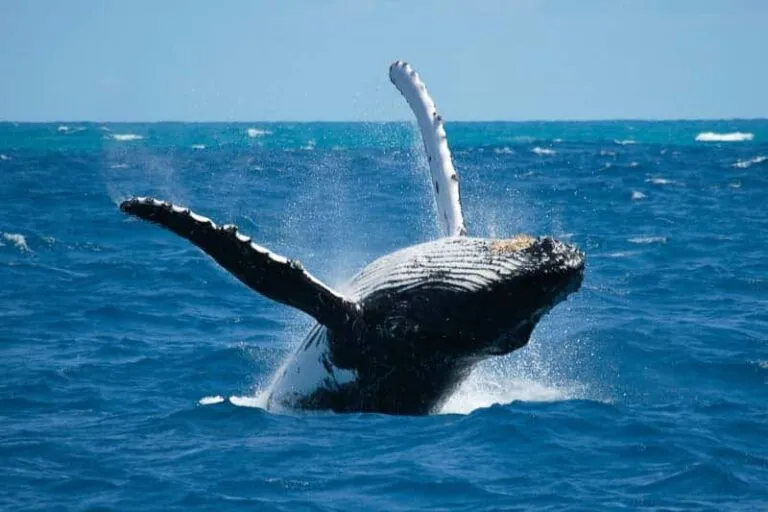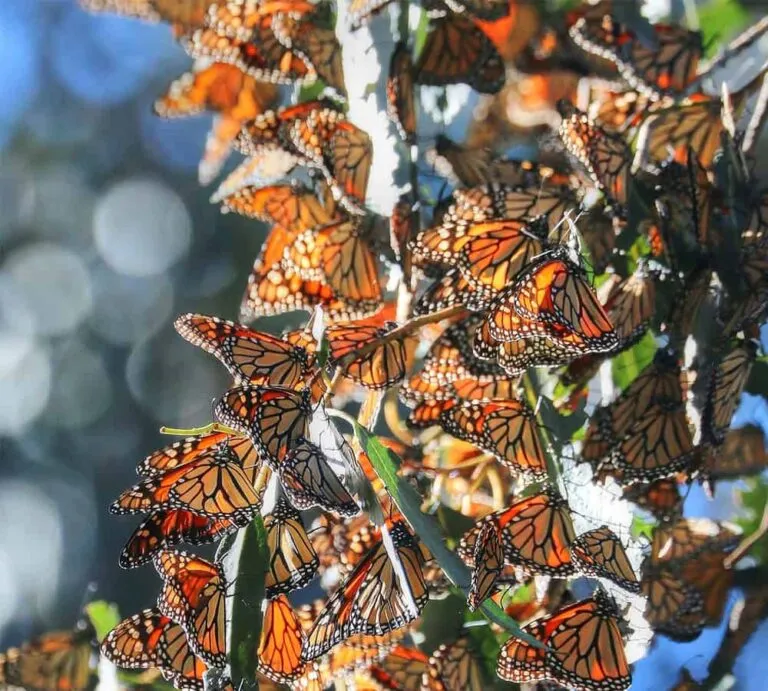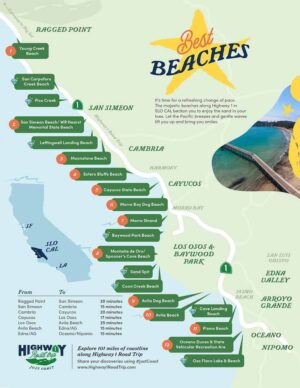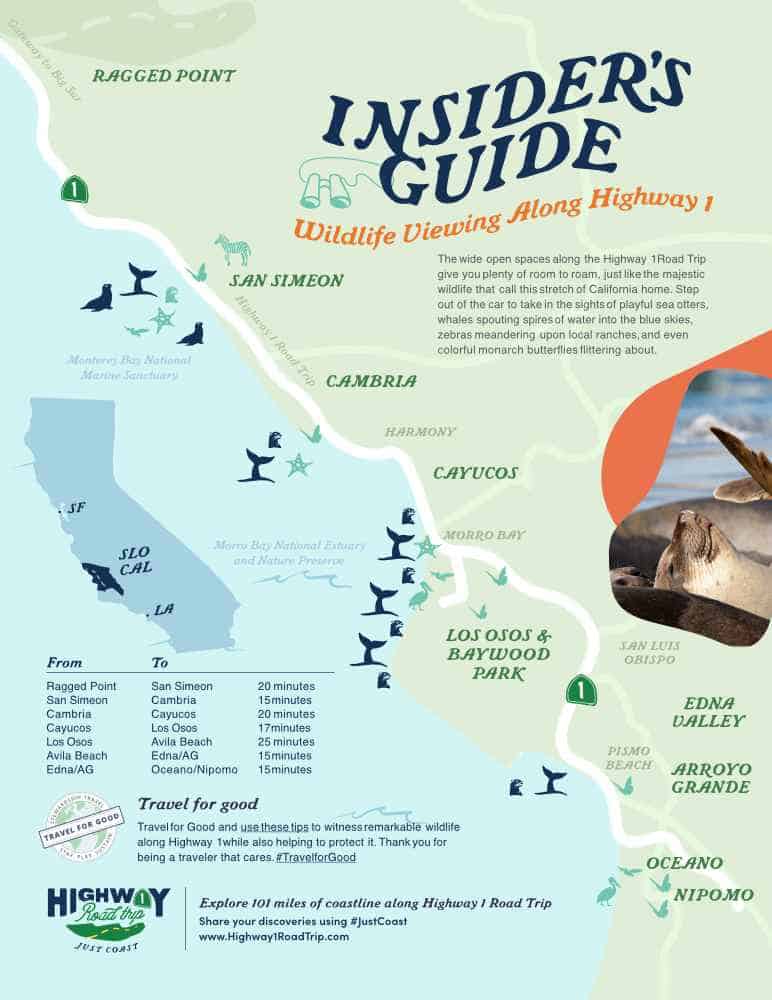California’s central coast award-winning Stewardship Travel Program provides a unique menu of over 50 activities for visitors to play, care, and connect deeper with local residents, scientists, naturalists, wildlife, and heritage sites located along the CA Highway 1 Road Trip in coastal San Luis Obispo County (SLO CAL). Stewardship Travel makes it easy for individuals and families to jump in along side locals for educational and conservation activities that are designed to be “bite size” to pair well with wine tasting and beach fun, examples include; citizen science ocean research in San Simeon Bay, stewardship sea kayaking in Cayucos, trail and habitat restoration in Montana de Oro State Park, historic lighthouse tours and perseveration opportunities in Avila Beach, along with opportunities to pitch in to protect wildlife with free beach clean-up kits and tote bags for the whole family in Cambria, Avila Beach, Cayucos and San Simeon.

Be outside during dawn, dusk and incoming tides
Birds, fish and mammals are active during these times. Look for churning water surfaces, diving birds, shiny dolphin backs, seals and otters in bays and on open water. Listen for songbirds singing in bushes and trees, especially during spring and early summer.
Be calm and stay a while
Adopt an unhurried ‘vacation’ state of mind. A state of relaxed alertness is the best way to see wildlife.
Blend in
Animals react to movement. Sit quietly next to a bush or tree and practice the ‘art of invisibility.’
Keep it steady
When kayaking, keep a slow, steady paddling rhythm. You’re more likely to have curious seals, otters, or dolphins approach you.
Zoom in
Use binoculars, spotting scopes, and zoom camera lenses to see wildlife action ‘up close at a distance’ that is less likely to disturb natural animal behaviors.
Look and listen for signs of wildlife
Look for animal tracks and droppings (scat). Large birds like ospreys, hawks, vultures, and cormorants leave noticeable white droppings (whitewash) on bushes, trees, sea cliffs and rocks. When you see this, lookup to find where birds roost or nest.

Low tide exposes fascinating and fragile life on the rocks
Venture carefully on rocks for a close-up peek into the exciting tidal world of animals feeding, interacting or waiting for the incoming tide.
Look for whales when seas are calm
Look for whale spouts or blows, tail flukes and dorsal fins. Big splashes may indicate a whale has just breached. Look for The Whale Trail viewing sites along the Highway 1 Road Trip.
Stay on trails
Going off trail may harm animal habitat or bird nesting areas. Keep dogs and children safe by staying on designated trails.
Watch where you step
In tide pools, walk on bare rock to avoid crushing fragile tide pool animals, and keep away from seaweed – it’s slippery! Please leave tide pool critters in their natural home. Tide booklets may be available in stores and real estate offices.
Stay at a distance, including drones
If birds and animals get nervous, they show it by looking at you, raising their heads and stopping what they are doing. Any change of an animal’s natural behavior is a disturbance.
Please do not feed wildlife
There is plenty of food available in the wild. Human food can create digestive problems and improper nutrition.

Stay away from animals that appear sick or abandoned
If you find an injured bird or land animal, you can help by calling Pacific Wildlife Care: 805.543.9453. If you suspect a marine animal is injured or in danger, call the Marine Mammal Center: 805.771.8300.
Be a stewardship traveler and lend a hand with trash removal
Human garbage is one of the greatest threats to wildlife. Get a Stewardship Traveler Clean-up Kit to pick up litter on the trail, the shore and even in the water. Free kits and appreciation tote bags are available in Avila Beach, Cayucos and Cambria visitor centers.
Connect with Nature
Thousands of animals migrate seasonally along the Highway 1 Road Trip. Plan your next trip around your favorite species or group of animals.
Elephant Seals: December, January, February and May
Female elephant seals, ready to give birth, arrive in December at Point Piedras Blancas. Thousands of pups are born in January. In February, elephant seal males fight for mating rights with females. In May, females return for the molt season.
Birds: December, January and February
San Luis Obispo County is considered a top birding spot in the US. Birds from northern climates spend winters in SLO County’s mild climate. Bird watchers arrive in December to participate in the worldwide annual Audubon Christmas Bird Count. Enjoy Morro Bay Winter Bird Festival in January and Avila Beach Bird Sanctuary Day in February.
Gray Whales: March, April and May
Females and their young calves travel close to shore on their northward migration from Mexico to Alaska. Peak numbers pass along the Central Coast from March through May. This is the best time for viewing gray whales. Follow The Whale Trail to watch them from shore! Gray whales migrate south during October and November.
Season of Ocean Abundance: August, September and October
Marine animals linger along the Central Coast, feeding on schools of sardines, anchovies and other small fish. Although ocean productivity may vary from year to year, this is the most likely time to see humpback whales, dolphins, sea lions and seabirds feeding close to shore.
Monarch Butterflies: November, December, January and February
Western Monarch butterflies spend winters in the mild climate of the Central Coast. The Monarch Grove in Pismo Beach/Oceano is the largest in the western US — each year millions of butterflies rest and mate in the tall eucalyptus trees.
Sea Otters: The Central Coast is one of the best places to observe sea otters! Look for them any time of year off the coast of Los Osos, Cayucos, Cambria and San Simeon.

Gateway to “Ah-ha” Moments!
Plan your next wildlife viewing adventure and make a difference through Stewardship Travel activities that protect wildlife, habitats, and cultural heritage sites.
Annual Coastal Discovery Celebration
STAY. PLAY. LEARN. CARE. Join us for the Annual Coastal Discovery Celebration January and February along the CA Highway 1 Road Trip.This seven week celebration includes a FREE movie showing Saturday nights at the Hearst Castle Theater, special events, and expert-guided activities. Immerse yourself in the local marine culture, coastal heritage and natural attractions of Coastal San Luis Obispo County by participating in award-winning Stewardship Travel adventures. Relax in any of our 500+ lodging properties, and take advantage of specials and packages.
Must-See Spots and Must-Do Stewardship Travel Activities
Check out our Stewardship Travel opportunities and learn how you can immerse yourself in every charming town of the CA Highway 1 Road Trip. Many hotels, motels, B&B’s, and vacation rentals offer Stewardship Traveler activity maps of the hidden gems and rural road trips of the CA Highway 1 Road Trip. Make sure to subscribe to the monthly E-newsletter below to receive the latest stewardship travel news, lodging deals, heritage tours and opportunities to win must-see, must-do getaways.
Valuable Expert Local Sources
Below are expert local sources of information on local wildlife education, protection and stewardship:
Morro Bay National Estuary Program
NOAA’s Monterey Bay National Marine Sanctuary
The Seabird Protection Network
Watchable Wildlife, Inc.
The Marine Mammal Center
Morro Coast Audubon Society
Pacific Wildlife Care
Sea Otter Savvy
For additional resources, check out the NOAA Marine Life Viewing Guidelines.
Special appreciation to: Morro Bay National Estuary Program, NOAA’s Monterey Bay National Marine Sanctuary, The Seabird Protection Network, Watchable Wildlife, Inc., The Marine Mammal Center, Morro Coast Audubon Society, Pacific Wildlife Care, and Friends of the Sea Otter




